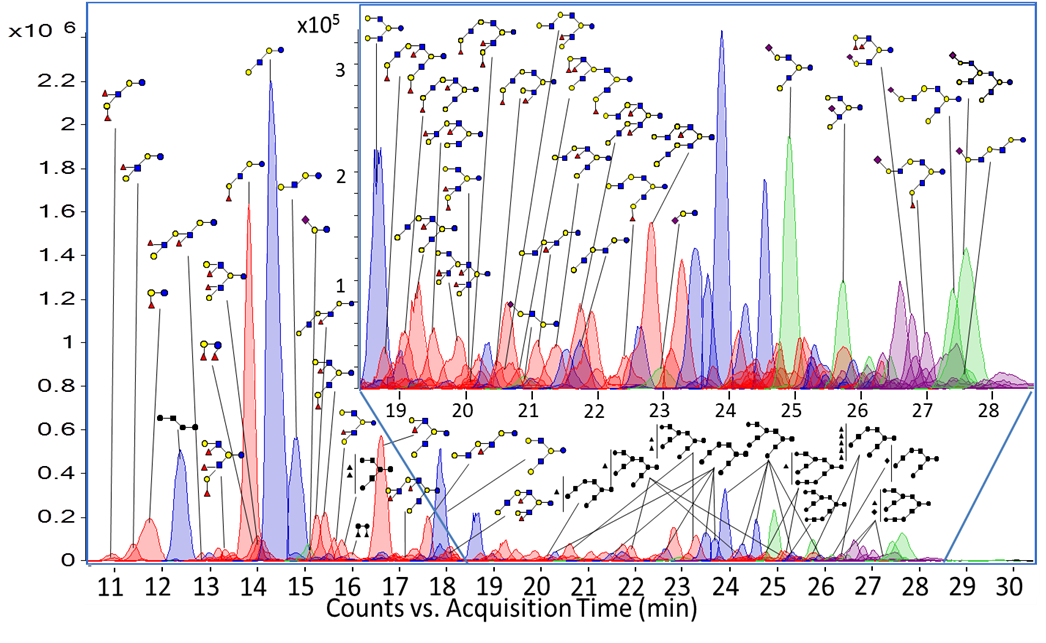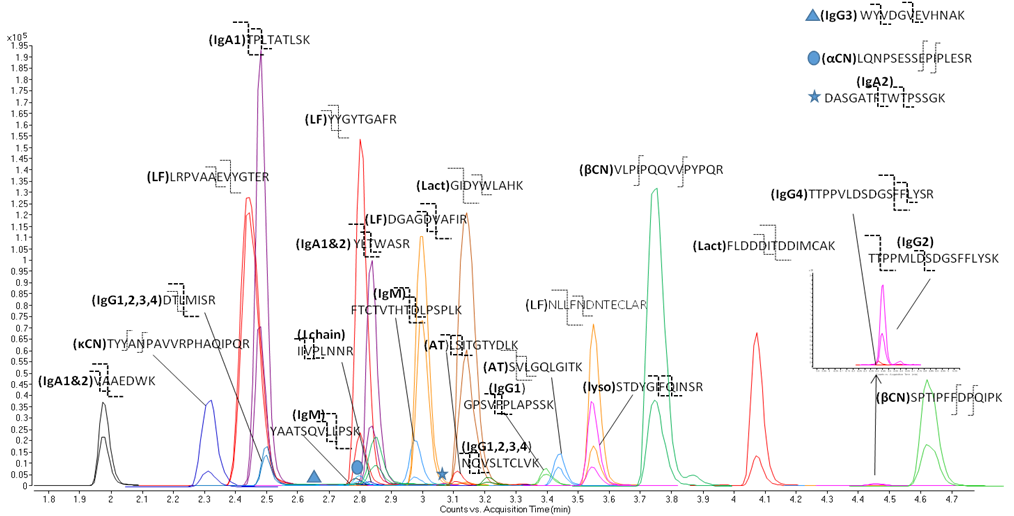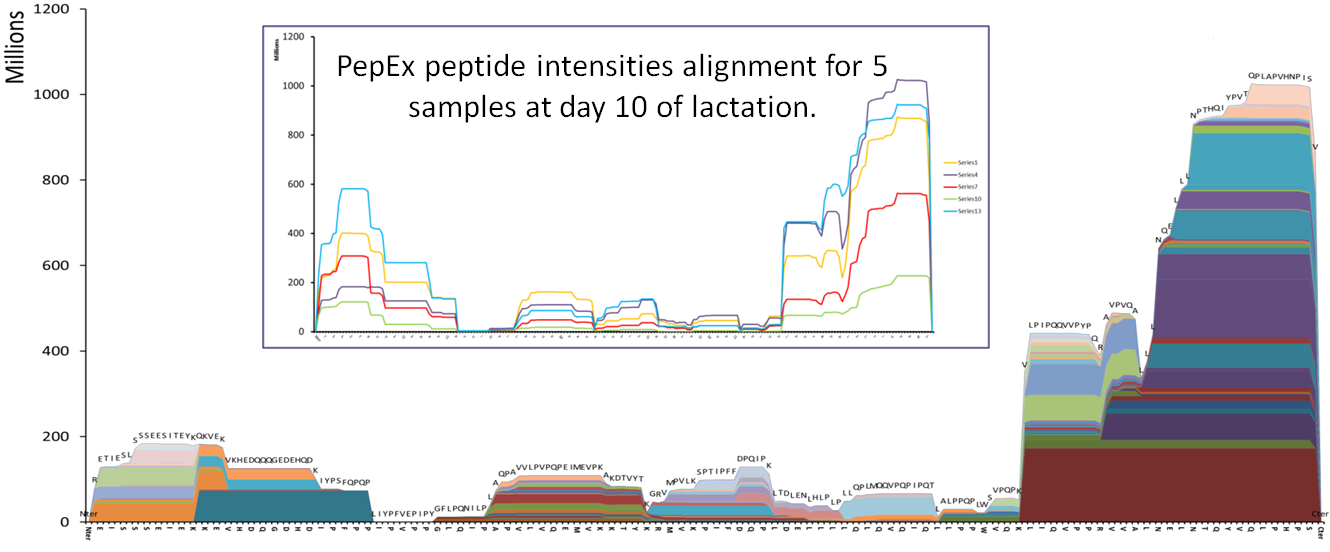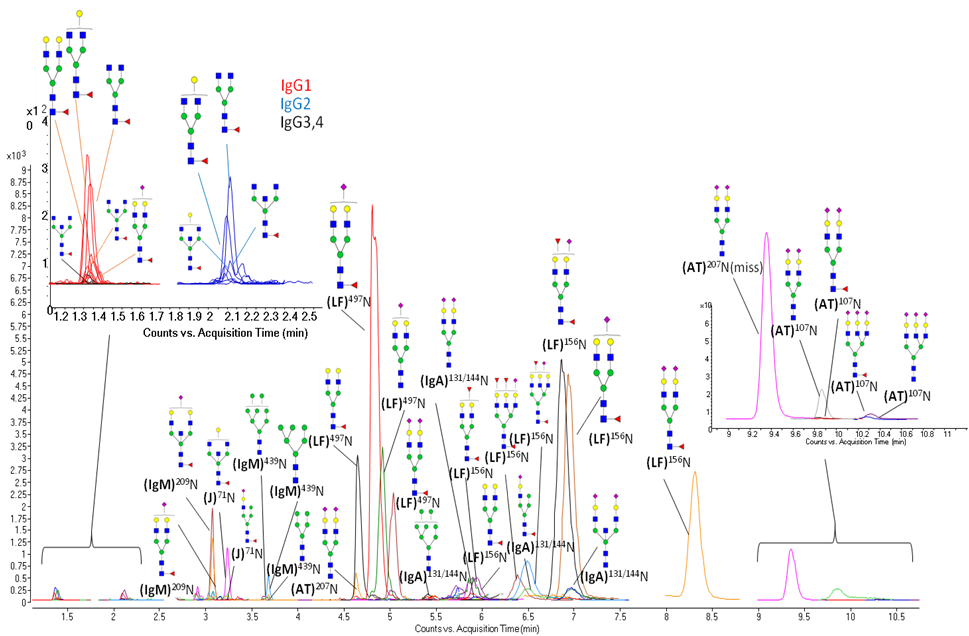Milk Glycomics
Human Milk Oligosaccharides (HMOs) are non-digestible sugars that benefit the health and development of infants (1,2). HMOs help certain beneficial bacteria proliferate in the infant’s intestines, suppressing the growth of some pathogenic bacteria (3). HMOs also interact with pathogenic bacteria, preventing the bacteria from binding to intestinal epithelial cells.
HMOs interact with bacteria by binding to the proteins on the surface of the bacterial cells. The binding to beneficial bacteria is the first step, followed by enzymatic hydrolysis of the glycosidic bonds and metabolism of the resulting monosaccharides by the bacteria. On the other hand, binding to pathogenic bacteria may be the only step in their interaction with pathogenic bacteria, blocking the bacteria from binding to the surface of the gut epithelial cells (4,5).
Unlike breast-fed infants, formula-fed infants develop a more adult-like intestinal microflora characterized by a lower percentage of beneficial bacteria (1,3). The adult-like microflora have been linked to reduced health of the immune system for infants and may be caused by the lack of HMOs in infant formula.
Although infant formulas contain non-digestible sugars (usually from plants), they are structurally and compositionally less complicated than HMOs (6). The non-digestible substitutes have not been altered to resemble HMOs because only a few characteristics are known that affect their interaction with the bacteria, such as size and fucosylation (5,7). Even after narrowing the category to small, fucosylated HMOs, the remaining HMOs can be categorized into groups such as branched vs. linear structures and Lewis type (a, b, x, or y). Some of these motifs may bind the bacteria more effectively than others.
Human milk also contains sugars conjugated to proteins and lipids. The role of the conjugated sugars is apparently different than the role of the free sugars (HMOs). Our goal to annotate all glycans of both free and conjugated forms and to investigate the timeliness of their biosynthesis as well as the specificity of their interaction with sugar binding molecules in the infant gut.
After creating a high throughput method, we can now quantify HMO profiles across a large batch of different populations, timepoints, and diseases .


Milk Glycoproteomics
Proteins are also one of the major components in milk and a large subset of milk proteins are glycosylated. These glycoproteins make prominent contributions to the health benefits ascribed to consuming milk. Our research aims at establishing structure-specific functional benefits of the unique protein glycosylation profiles in milk.
To this end, strategies involving MS-based proteomics, gel-based quantitative protein profiling, and site specific glycosylation analysis are being used to establish the milk glycoproteome.

Milk Peptidomics
Milk is a self-digesting biofluid rich in proteolytic enzymes. A comprehensive study of the peptide content in human milk has revealed a vast diversity of naturally occurring peptides (NOPs). A human milk NOPs library has been created with more than 800 unique sequences from 34 proteins.

Human milk samples from 5 different mothers at three different timepoints of lactation were studied via HPLC Chip/Q-TOF. NOPs intensities were grouped, mapped and interpreted using an in-house software.

References
- Davis M.K. Breastfeeding in chronic disease in childhood and adolescence. Pediatr. Clin. North Am 2001, 48, 125-141.
- Boehm, Günther; Moro, Guido. Structural and Functional Aspects of Prebiotics Used in Infant Nutrition. J. Nutr. 2008, 138, 1818S-1828S.
- Harmsen H.J.; Wildeboer-Veloo A.C.; Raangs G.C.; Wagendorp A.A.; Klijn N.; Bindels J.; Welling G.W.. Analysis of intestinal flora development in breast fed and formula fed infants by using molecular identification and detection methods. J. Pediatr. Gastroenterol. Nutr. 2000, 30, 61-67
- Boehm, Günther; Moro, Guido. Structural and Functional Aspects of Prebiotics Used in Infant Nutrition. J. Nutr. 2008, 138, 1818S-1828S.
- LoCascio, Riccardo G.; Ninonuevo, Milady R.; Freeman, Smara L.; Sela, David A.; Grimm, Rudolf; Lebrilla, Carlito B.; Mills, David A.; German, J. Bruce. Glycoprofiling of Bifidobacterial Consumption of Human Milk Oligosaccharides Demonstrates Strain Specific, Preferential Consumption of Small Chain Glycans Secreted in Early Human Lactation. J. Agric. Food Chem. 2007, 55, 8914-8919.
- Boehm, Günther; Stahl, Bernd. Oligosaccharides from Milk. J. Nutr. 2007, 137, 847S-849S.
- Newburg D.S.; Ruiz-Palacios G.M.; Altaye M.; Chaturvedi P.; Meinzen-Derr J.; Guerrero M.D.; Morrow A.L.. Innate protection conferred by fucosylated oligosaccharides of human milk against diarrhea in breastfed infants. Glycobiology 2004, 14, 253-263.
- Dallas DC, Guerrero A, Parker EA, Robinson RC, Gan J, German JB, Barile D, Lebrilla CB (2015) Current peptidomics- Applications, purification, identification, quantification, and functional analysis. Proteomics 15 (5-6):1026-1038. doi:10.1002/pmic.201400310
- De Leoz ML, Kalanetra KM, Bokulich NA, Strum JS, Underwood MA, German JB, Mills DA, Lebrilla CB (2014) Human Milk Glycomics and Gut Microbial Genomics in Infant Feces Show a Correlation between Human Milk Oligosaccharides and Gut Microbiota- A Proof-of-Concept Study. Journal of proteome research. doi:10.1021/pr500759e
- De Leoz ML, Wu S, Strum JS, Ninonuevo MR, Gaerlan SC, Mirmiran M, German JB, Mills DA, Lebrilla CB, Underwood MA (2013) A quantitative and comprehensive method to analyze human milk oligosaccharide structures in the urine and feces of infants.. Analytical and bioanalytical chemistry 405 (12):4089-4105. doi:10.1007/s00216-013-6817-1
- Guerrero A, Dallas DC, Contreras S, Bhandari A, Canovas A, Islas-Trejo A, Medrano JF, Parker EA, Wang M, Hettinga K, Chee S, German JB, Barile D, Lebrilla CB (2015) Peptidomic analysis of healthy and subclinically mastitic bovine milk. International dairy journal / published in association with the International Dairy Federation 46:46-52. doi:10.1016/j.idairyj.2014.09.006
- Hong Q, Ruhaak LR, Totten SM, Smilowitz JT, German JB, Lebrilla CB (2014) Label Free Absolute Quantitation of Oligosaccharides using Multiple Reaction Monitoring.. Analytical chemistry. doi:10.1021/ac404006z
- Huang J, Guerrero A, Parker E, Strum JS, Smilowitz JT, German JB, Lebrilla CB (2015) Site-specific Glycosylation of Secretory Immunoglobulin A from Human Colostrum. Journal of proteome research. doi:10.1021/pr500826q
- Newburg DS, Ruiz-Palacios GM, Morrow AL (2005) Human milk glycans protect infants against enteric pathogens. Annual review of nutrition 25:37-58. doi:10.1146/annurev.nutr.25.050304.092553
- Ruhaak LR, Lebrilla CB (2012) Analysis and role of oligosaccharides in milk.. BMB reports 45 (8):442-451. doi:10.5483/BMBRep.2012.45.8.161
- Ruhaak LR, Lebrilla CB (2012) Advances in analysis of human milk oligosaccharides.. Advances in nutrition 3 (3):406S-414S. doi:10.3945/an.112.001883
- Smilowitz JT, Lebrilla CB, Mills DA, German JB, Freeman SL (2014) Breast Milk Oligosaccharides: Structure-Function Relationships in the Neonate. Annual review of nutrition 34:143-169. doi:10.1146/annurev-nutr-071813-105721
- Totten SM, Wu LD, Parker EA, Davis JC, Hua S, Stroble C, Ruhaak LR, Smilowitz JT, German JB, Lebrilla CB (2014) Rapid-throughput glycomics applied to human milk oligosaccharide profiling for large human studies. Analytical and bioanalytical chemistry 406 (30):7925-7935. doi:10.1007/s00216-014-8261-2
- Totten SM, Zivkovic AM, Wu S, Ngyuen U, Freeman SL, Ruhaak LR, Darboe MK, German JB, Prentice AM, Lebrilla CB (2012) Comprehensive profiles of human milk oligosaccharides yield highly sensitive and specific markers for determining secretor status in lactating mothers.. Journal of proteome research 11 (12):6124-6133. doi:10.1021/pr300769g
- Wu S, Grimm R, German JB, Lebrilla CB (2011) Annotation and structural analysis of sialylated human milk oligosaccharides. Journal of proteome research 10 (2):856-868. doi:10.1021/pr101006u
- Wu S, Tao N, German JB, Grimm R, Lebrilla CB (2010) Development of an annotated library of neutral human milk oligosaccharides.. Journal of proteome research 9 (8):4138-4151. doi:10.1021/pr100362f
